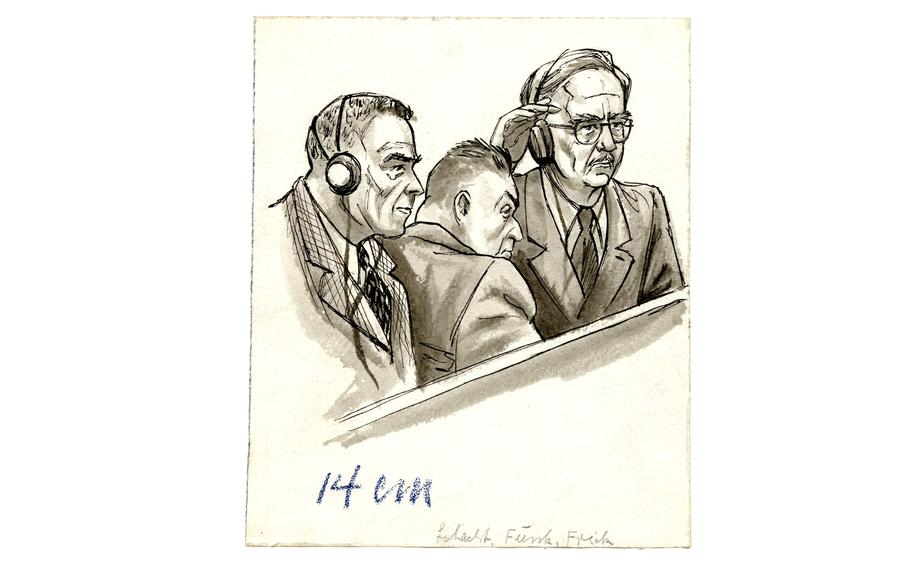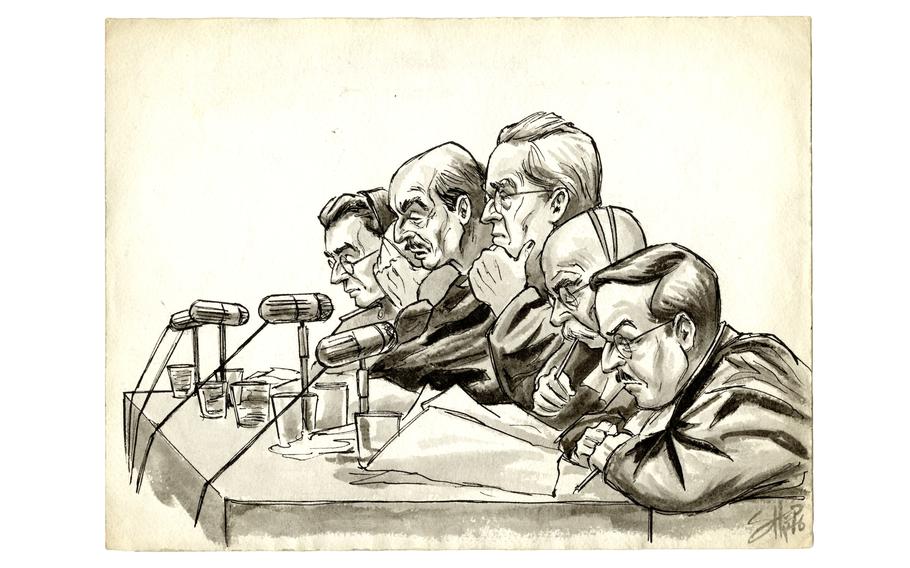
From left, Wilhelm Frick, Minister of Interior and “Reichsleiter,” the second highest rank in the Nazi Party and instrumental in the creation of the anti-Semitic and racial Nazi policies; Walther Funk, Minister for the Economy (1938-1945), and President of the Reichsbank (National Bank) (1939-1945); Hjalmar Schacht, Minister for the Economy (1934-1937), and President of the Reichsbank (1935-1937) at the International Military Tribunal in Nuremberg, Germany. (Don Sheppard/Stars and Stripes)
This article first appeared in the Stars and Stripes European edition, Oct. 2, 1946. It is republished unedited in its original form. The accompanying sketches were all created by Stars and Stripes artist Don “Shep” Sheppard on Oct. 1, 1946. Shep was present in the court room at the Palace of Justice in Nuremberg that day and sketched the defendants as they heard the verdict against them read.
NURNBERG, Oct. 1 — Hermann Goering and 11 of his Nazi cohorts today were sentenced to death by hanging for their parts in the crimes committed against peace and humanity, and for participation in plans made for war during the 12 years of Hitler rule in Germany.
Seven of the 21 defendants who had faced the International Military Tribunal for the past 10 months, including Rudolf Hess, were given prison sentences ranging from 10 years to life.
Three, Franz von Papen, Hjalmar Schacht, and Hans Fritzsche, were free men today as a result of the court’s declaration that they were innocent of all four counts in the mass indictment.
The sentences on the convicted Nazis, in the order in which they sat in the prisoners’ box during the 10 long months, follow:
Hermann Goering: Death by hanging.
Rudolf Hess: Life imprisonment.
Joachim von Ribbentrop: Death by hanging.
Wilhelm Keitel: Death by hanging. (The court apparently refused to consider a request that any of the military men condemned to die be given a “soldier’s” death by firing squad.)
Ernst Kaltenbrunner: Death by hanging.
Alfred Rosenberg: Death by hanging.
Hans Frank: Death by hanging.
Wilhelm Frick: Death by hanging.
Julius Streicher: Death by hanging.
Walther Funk: Life imprisonment.
Karl Doenitz: 10 years imprisonment.
Erich Raeder: Life imprisonment.
Baldur von Schirach: 20 years imprisonment
Fritz Sauckel: Death by hanging.
Alfred Jodl: Death by hanging.
Arthur Seyss-Inquart: Death by Hanging.
Albert Speer: 20 years imprisonment.
Konstantin von Neurath: 15 years imprisonment.
Martin Bormann: who has never been found by the Allies but was tried in absentia, also was condemned to death by hanging.
The defendants filed in individually to hear their sentences and each stood alone in the prisoners dock as black-robed Lord Justice Geoffrey Lawrence, president of the court, matter of factly pronounced the verdicts.
Following the last sentence, Justice Lawrence announced that the two Russian members of the four-power tribunal had dissented from the majority opinions in the three acquittals and in the sentence on Hess.
The Russians also disagreed with the absolution from organizational guilt of the German general staff and high command and of the Reich cabinet.
By pre-established procedure, the 11 condemned are to be hanged within 15 days, or by Oct. 16. However, counsel for all defendants, including those merely sentenced to imprisonment, announced immediately that all sentences would be appealed to the Allied Control Council.
One by one the defendants were called into the dock to hear their sentences. For the first time since the tribunal first sat on Nov. 20, 1945. The dock was empty except for two American Army lieutenants at either end.
As the hand of the wall clock behind the dock swung to 2:53 p.m., the door that leads to a special elevator used by the prisoners swung open and Hermann Goering stepped out into the rear row of the dock.
Flanked by two GI guards, who escorted each defendant, Germany’s former number two Nazi was handed a four-language headset through which to hear his sentence.
Standing almost placidly facing his judges, the defendant stood listening to the beginning of his sentencing when a technical difficulty made it impossible for him to hear the words of Justice Lawrence.
The difficulty having been remedied, an almost benign Goering heard the British justice pronounce the phrase “on the counts of the indictment on which you have been convicted, the tribunal sentences you to death by hanging.”
There were hardly any dramatics to this culmination of more than a decade of hope by suffering peoples and 10 months of almost continues judicial work.
Chief Justice Lawrence, who rea all the sentences, did so in a calm, hardly-modulated voice, beginning always with the defendant’s name and the words “by counts of the indictment by which you have been convicted the tribunal sentences you to …”

Four of the nine judges of the International Military Tribunal at Nuremberg, Germany on the day the verdict was read, Oct. 1, 1946, as sketched by Stars and Stripes artist Don “Shep” Sheppard. Sheppard did not identify all of the judges in the drawing, only the U.S. main judge Francis Biddle (second from left). The full version sat all eight judges from the four participating nations: United States, Great Britain, France, and the Soviet Union. (Don Sheppard/Stars and Stripes)
Goering First
The first to hear these words was Goering who, in pale gray suit and face to match, entered the dock from the elevator to the prisoners’ cells, escorted by two white-helmeted MPs.
Lawrence, however, had to repeat his words twice, for the first two sets of earphones which the former number two Nazi tried on did not work. A U.S. captain hurried into the dock, repaired the damage, sentence was passed and the two MPs led Goering back to his cell.
Roughly three minutes later Rudolf Hess appeared. Still acting as strangely as he had throughout the trial. Hess refused to don the earphones, staring into space as he heard himself condemned to prison for life.
At approximately four-minute intervals, the defendants were led individually to their place at the rear of the dock, before hearing their fates and being led out again.
Ribbentrop still clutched a sheaf of papers under his arm as he entered to hear the tribunal’s decision. After laying down the papers on a bench and hearing the sentence of death, he stood waiting blankly, as though bewildered that such a simple pronouncement was commensurate with the end of one who had formerly occupied positions of such importance.
Keitel at Attention
Former Filed Marshal Keitel, standing at ramrod attention, blinked almost imperceptibly as he heard the word “hanging.”
Nazi philosopher Alfred Rosenberg listened as he stood alone in the center of the box with his head cocked slightly to the side. As he hard the sentence he stood adjusting his coat, and then tore off the earphones, half glanced in pseudo-defiance at his judges and literally bolted out of the door.
Tall, scar-faced Kaltenbrunner, second in command to Gestapo chief Henirich Himmler, had an ironic bow for the court as he too heard the words “death by hanging.”
Hans Frank, Jew-murderer, heard the same words a few moments later and nodded.
Julius Streicher, who looked like one of the fiendish Jewish caricatures with which he used to adorn the pages of his Der Sturmer, stood stoically as he discovered that his conviction on only one of the indictments was enough to earn him the gallows.
Similarly, Frick, looking worn, and Rader and Doenitz remained passive, or bowed slightly as the judgement was pronounced.
Von Schirach Angered
Almost the only signs of emotions were Funk’s look of disgust as the conversational voice of the justice said “life imprisonment” and youth leader Von Schirach’s almost sneering anger for being given 20 years in prison.
Von Schirach had to be hustled out of the docks by the MPs as he stood staring at the court.
One-time mass enslaver Sauckel also had a sneer.
Don Sheppard was the last of no less than three Stars and Stripes artists to sketch the so-called Nuremberg trials. Ed Vebell’s and Jean Baird’s sketches were published in Stars and Stripes in the month of December 1945 and can be seen below. Nine of Vebell’s original drawings can be found at the United States Holocaust Memorial Museum in Washington, D.C.